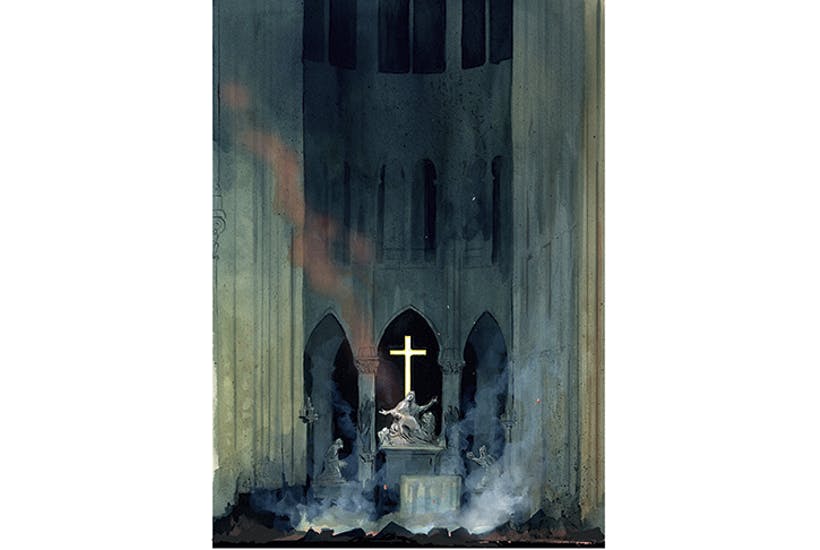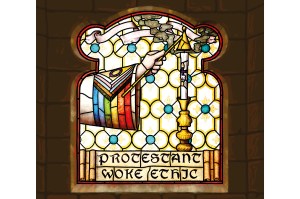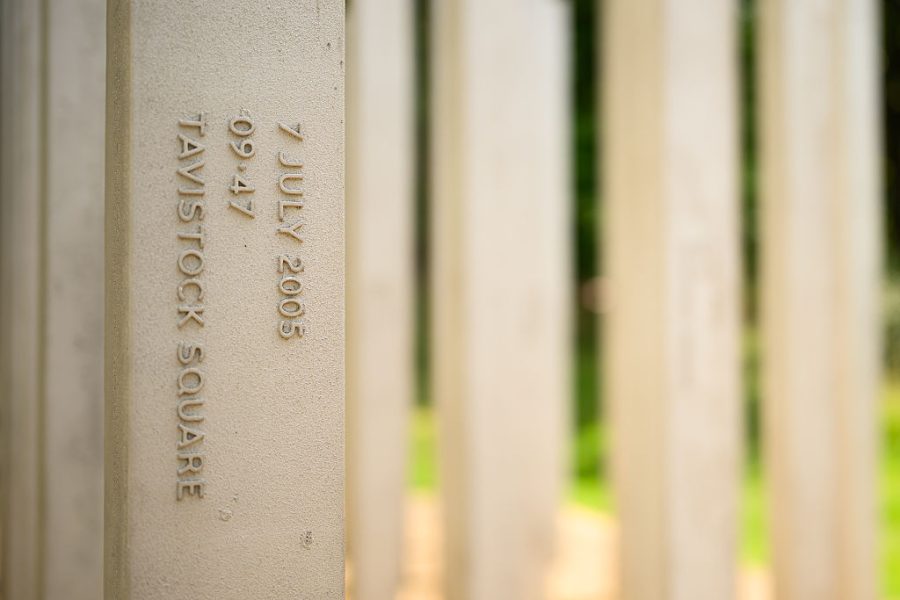Declarations of hope that Notre-Dame can be resurrected have been much in evidence this Holy Week. Such is the lesson of Easter: that life can come from death. Unlike the Eiffel Tower, that other great emblem of Paris, Notre-Dame provides the French with evidence that their modern and secular republic has its foundations deeply rooted in the Middle Ages. Notre-Dame has always been more than just an assemblage of stone and stained glass. It is a monument as well to a specifically Christian past.
Last summer, one of the world’s best-known scientists, a man as celebrated for his polemics against religion as for his writings on evolutionary biology, sat in another cathedral, Winchester, in the United Kingdom, listening to the bells peal. ‘So much nicer than the aggressive-sounding “Allahu Akhbar”,’ Richard Dawkins tweeted. ‘Or is that just my cultural upbringing?’ A preference for church bells over the sound of Muslims praising God does not just emerge by magic. Dawkins — agnostic, secularist and humanist that he is — absolutely has the instincts of someone brought up in a Christian civilization.
Perhaps, then, the debt of the contemporary West to Christianity is more deeply rooted than many — believers and non-believers alike — might presume.
Today, as the flood-tide of western power and influence ebbs, the illusions of European and American liberals risk being left stranded. Much that they have sought to cast as universal stands exposed as never having been anything of the kind. Free-thinkers who mock the very idea of a god as a sky fairy, an imaginary friend, still hold to taboos and morals that palpably derive from Christianity. In 2002, in Amsterdam, the World Humanist Congress affirmed ‘the worth, dignity and autonomy of the individual and the right of every human being to the greatest possible freedom compatible with the rights of others’. Yet this — despite humanists’ stated ambition to provide ‘an alternative to dogmatic religion’ — was nothing if not itself a statement of belief. The humanist assumption that atheism and a concern for human life go together was just that: an assumption. What basis — other than mere sentimentality — was there to argue for it? Perhaps, as the humanist manifesto declared, through ‘the application of the methods of science’. Yet this was barely any less of a myth than the biblical story that God had created humanity in his own image. It is not truth that science offers moralists, but a mirror. Racists identify it with racist values; liberals with liberal values. The primary dogma of humanism — ‘that morality is an intrinsic part of human nature based on understanding and a concern for others’ — finds no more corroboration in science than did the dogma of the Nazis that anyone not fit for life should be exterminated. The wellspring of humanist values lies not in reason, not in evidence-based thinking, but in the past, and specifically in the story of how a cult inspired by the execution of an obscure criminal in a long-vanished empire emerged to become — as the great Jewish scholar Daniel Boyarin has put it — ‘the most powerful of hegemonic cultural systems in the history of the world’.
The Easter story lies at the heart of this narrative. Crucifixion, in the opinion of Roman intellectuals, was not a punishment just like any other. It was one peculiarly suited to slaves. To be hung naked, helpless to beat away the clamorous birds, ‘long in agony’, as the philosopher Seneca put it, ‘swelling with ugly weals on shoulder and chest’, was the very worst of fates. Yet in the exposure of the crucified to the public gaze there lurked a paradox. So foul was the carrion-reek of their disgrace that many felt tainted even by viewing a crucifixion. Certainly, few cared to think about it in any detail. Order, the order loved by the gods and upheld by magistrates vested with the full authority of the greatest power on earth, was what counted — not the elimination of such vermin as presumed to challenge it. Some deaths were so vile, so squalid, that it was best to draw a veil across them entirely.
The surprise, then, is less that we should have so few procedural descriptions in ancient literature of what a crucifixion might actually involve, than that we should have any at all. Nevertheless, amid the general silence, there is one major exception which proves the rule. Four detailed accounts of the process by which a man might be sentenced to the cross, and then suffer his punishment, have survived from antiquity. These accounts are to be found, of course, in the New Testament. There is no reason to doubt their essentials. Even the most skeptical historians have tended to accept them. In the words of one of the most distinguished, Geza Vermes, ‘The death of Jesus of Nazareth on the cross is an established fact, arguably the only established fact about him.’
Altogether more controversial, of course, are the stories of what happened next. That women, going to the tomb, found the entrance stone rolled away. That Jesus, over the course of the next 40 days, appeared to his followers, not as a ghost or a reanimated corpse, but resurrected into a new and glorious form. That he ascended into heaven, and was destined to come again. Time would see him hailed, not just as a man, but as a god. By enduring the most agonizing fate imaginable, he had conquered death itself. ‘Therefore God has highly exalted him and bestowed on him the name which is above every name, that at the name of Jesus every knee should bow, in heaven and on earth and under the earth…’
The utter strangeness of all this, for the vast majority of people in the Roman world, did not lie in the notion that a mortal might become divine. The border between the heavenly and the earthly was widely held to be permeable. Divinity, however, was for the very greatest of the great: for victors, and heroes, and kings. Its measure was the power to torture one’s enemies, not to suffer it oneself. Even Christians, in the early years of the cult, might flinch at staring the manner of Jesus’s death full in the face. They were as wise to the connotations of crucifixion as anyone. Paul, the most successful and influential of early missionaries, readily described Christ’s execution as a ‘scandal’. The shame of it was long felt. Only centuries after the death of Jesus did his crucifixion at last start to emerge as an acceptable theme for artists. By 400 ad the cross was ceasing to be viewed as something shameful. Banned as a punishment decades earlier by Constantine, the first Christian emperor, crucifixion had come to serve the Roman people as an emblem of triumph over sin and death. An artist, carving the scene out of ivory, might represent Jesus in the skimpy loincloth of an athlete. Far from looking broken, he would be shown as no less muscled, no less ripped than any of the ancient gods.
We are the heirs to a later, much more unsettling way of portraying Christ’s crucifixion. The Jesus painted or sculpted by medieval artists, twisted, bloody, dying, was a victim of torture such as his original executioners would have recognized. The response to the spectacle, though, was far removed from the mingled revulsion and disdain that had typified that of the ancients to crucifixion. Christians in the Middle Ages, when they looked upon an image of their Lord upon the cross, upon the nails smashed through the tendons and bone of his feet, upon the arms stretched so tightly as to appear torn from their sockets, upon the slump of his thorn-crowned head on to his chest, did not feel contempt, but rather compassion, and pity, and fear. That the Son of God, born of a woman, and sentenced to the death of a slave, had perished unrecognized by his judges, was a reflection fit to give pause to even the haughtiest monarch. This awareness could not help but lodge in the consciousness of medieval Christians a visceral and momentous suspicion: that God was closer to the weak than to the mighty, to the poor than to the rich. Any beggar, any criminal, might be Christ. ‘So the last will be first, and the first last.’
Christianity had revealed to the world a momentous truth: that to be a victim might be a source of strength. No one in modern times saw this more clearly than the religion’s most brilliant and unsparing critic. Because of Christianity, wrote Friedrich Nietzsche, ‘the measure of a man’s compassion for the lowly and suffering comes to be the measure of the loftiness of his soul’. The commanding heights of western culture may now be occupied by people who dismiss Christianity as superstition; but their instincts and assumptions remain no less Christian for that. If God is indeed dead, then his shadow, immense and dreadful, continues to flicker even as his corpse lies cold. The risen Christ cannot be eluded simply by refusing to believe in him. That the persecuted and disadvantaged have claims upon the privileged — widely taken for granted though it may be today across the West — is not remotely a self-evident truth. Condemnations of Christianity as patriarchal or repressive or hegemonic derive from a framework of values that is itself nothing if not Christian.
Familiarity with the Easter story has desensitized us to what both Paul and Nietzsche, in their very different ways, instinctively recognized in it: a scandal. The cross, that ancient tool of imperial power, remains what it has always been: the fitting symbol of a transfiguration in the affairs of humanity as profound and far-reaching as any in history. ‘God chose the weak things of the world to shame the strong.’ It is the audacity of it — the audacity of finding in a twisted and defeated corpse the glory of the creator of the universe — that serves to explain, more surely than anything else, the sheer strangeness of Christianity, and of the civilization to which it gave birth.
Today, the power of this strangeness remains as alive as it has ever been. It is manifest in the great surge of conversions that has swept Africa and Asia over the past century; in the conviction of millions upon millions that the breath of the Spirit, like a living fire, still blows upon the world; and, in Europe and North America, in the assumptions of many more millions who would never think to describe themselves as Christian. All are heirs to the same revolution:
a revolution that has, at its molten heart, the image of a god dead upon an implement of torture.
This article was originally published in The Spectator magazine.

























